Back to Chantha’s Death – Witness Testifies on Killings of Vietnamese
In today’s session in front of the ECCC the testimony of Prum Sarun came to an end. He provided more details about the arrests and killings of people in his area. Next, witness Um Sun was questioned about a massacre of a number of Vietnamese people at Khsach Pagoda that he says he witnessed. This massacre had been described by witness Sean Sung earlier this year. Sun and Sung both told the Court that they witnessed the killing of Vietnamese people together . Amongst the killed Vietnamese was a young girl Chantha whose death had vividly been described in the second day of Sean Sung’s testimony. The numbers of victims they saw differs. Nuon Chea Defense Counsel Victor Koppe doubted the reliability of this story in its entirety and therefore did not pose any questions to the witness after having been prevented by the President Nil Nonnto ask the witness directly whether he lied.
Killing of people and dead bodies
At the beginning of the session, Trial Chamber Greffier Em Hoy confirmed the presence of all parties, with Nuon Chea following the proceedings from the holding cell. Defense Counsel Kong Sam Onn was late due to traffic congestion.
The President Nil Nonn then gave the floor to Judge Lavergne who posed a few questions to the witness.
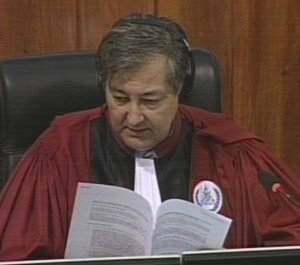
Judge Jean-Marc Lavergne
He inquired about the locations of executions and asked about Tuol Ta Trong, where the witness had seen bodies. Mr. Sarun stated that he saw bodies of children. He did not know whether they were Khmer or Vietnamese. Judge Lavergne then wanted to know where he saw the termite mount that he had mentioned before. Mr. Sarun replied that there was a termite mount at Tuol Ta Trong. He said that he never saw arrests. This prompted Judge Lavergne to refer to the witness’s interview.[1] “In 1976, the Vietnamese were sought after by the Khmer Rouge. […]. And I saw these Vietnamese people being tied up and executed.” Judge Lavergne wanted to know which version was correct. The witness replied that this was a lengthy question and that he stood by his previous answer. Pressed on by Judge Lavergne, Mr. Sarun stated that he stood by his OCIJ interview. As for the children that were mentioned in his interview as having killed people who were arrested, Mr. Sarun recalled that there were children who carried guns. “Of course when they arrested people, they killed them.”
Judge Lavergne then inquired about Au Pongmoan. The witness replied that a soldier and his wife were shot dead there. It was close to his village. When he walked to that area, “they had already died.” However, “we had to bury them, because otherwise the stench would be too strong.”
Judge Lavergne asked whether Pol Touch that was close to a stream was another location. The witness replied that he saw people starving to death. Many people from Pailin were brought away.
Judge Lavergne the inquired about the White Stairs that Mr. Sarun had mentioned. Mr. Sarun replied that they belonged to Wat Kirirum. He only saw them after the fall of the regime. He saw a cave that was “half full.” He did not see people being killed there. He only saw the dead body of his supervisor Ta Oeum, who was killed to the north of the mountain.
Judge Lavergne turned to the topic of detention centers. Mr. Sarun replied that there was a valley between two mountains, where the stairs let up to Wat Kirirum. As for Samnang Village, he said that there was no detention center. People were provisionally detained on the White Stairs leading to Wat Kirirum. He had not heard about Louy Village.
Judge Lavergne then referred to Im An’s statement – a monk who had talked about a person called Yeay Nae – and asked whether Mr. Sarun knew the person that the monk had mentioned.[2] The witness had not heard about a person called Nae.
Judge Lavergne then inquired whether the cadres who were arrested were replaced by other cadres. The witness gave the example of Ta Cheng replacing Ta Chham. They were called to a meeting. A person – Ta Daok – and his child were accused of being a traitor and killed. He was smashed because he concealed weapons. Mr. Sarun did not know what kind of weapons there were. There were no Cham in his village. With this, Judge Lavergne concluded his questioning.
Nuon Chea Defense Counsel Victor Koppe was given the floor. He asked about Chham and his roles. The witness replied that he instructed them to build a dam at Kamping Puoy. He had a house there, but disappeared later. Next, Ta Chheng came and replaced him. He did not know anything else about the disappearance. Ta Chham was the deputy district secretary. Mr. Koppe asked whether his full name was Chin Chham. Mr. Sarun replied that he did not know his full name. He could not recall the year when the replacement took place. Asked whether it could have been January 1978, he said that it might have been around that time.
He did not know Ta Hoeun.
Targeting of Lon Nol Officials
Mr. Koppe then turned to Mr. Sarun’s personal biography. Mr. Sarun confirmed that he had been a soldier in Battalion 164 during the Lon Nol regime. He spent one year in the army. Then, he was sent to Thailand to study Thai, where he stayed one year. He was sent by the army. After this, he received training for three months. He changed his uniform to civilian clothes when the zone was liberated. He confirmed Mr. Koppe’s follow-up question whether he was therefore in the army for 3.5 years. Mr. Koppe asked whether Mr. Sarun joined the Khmer Republic army at Krapeu Cheung, which the witness confirmed. Mr. Koppe asked whether people in his village knew that he had been in the army for 3.5 years, which Mr. Sarun also confirmed. He affirmed that the cadres in his village also knew this.
Mr. Koppe then asked whether it was correct that cadres monitored him after 1975, as Mr. Sarun had indicated in his statement. Mr. Sarun confirmed this and remembered that they investigated his background and monitored him. They kept him, according to Mr. Sarun, because he was hard-working.
Mr. Koppe then referred to his statement, in which he had said that “they had me make a biography once a year […] to send to the upper echelon.”[3] Mr. Sarun confirmed that they instructed him to make a biography once a year. Mr. Koppe then asked whether he knew other members from Battalion 164 who also left the army in April 1975 and were monitored like the witness. Mr. Sarun replied that “they followed only me.” However, every soldier was required to make biographies. His unit chief Oeun was killed. “But they kept me alive to be useful working.”
Mr. Koppe then inquired whether soldiers were required to assemble at Wat Sambeou, which the witness did not know.
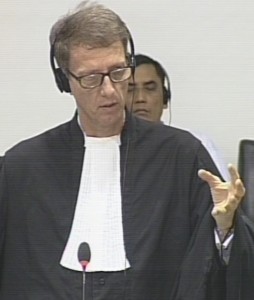
International Nuon Chea Defense Counsel Victor Koppe
Mr. Koppe referred to another witness’s statement, who had talked about how 300-400 soldiers had been disarmed by more than 100 Khmer Rouge soldiers and then assembled at Wat Sampeou. Two days later, trucks transported these soldiers away to “have them work at the rice fields.”[4] Mr. Sarun said that he had not heard about this. He did not know where they were transported to. Neither had he heard about stories that Lon Nol soldiers were sent to work in rice fields or cotton plantations.
Mr. Koppe then inquired about the speech by Muol Sambat alias Ta Nhim that Mr. Sarun had mentioned in his Written Record of Interview. Mr. Sarun replied that he was instructed to attend a meeting where Ta Nhim held a speech. He could not see Ta Nhim’s face, since there were many people attending the meeting and Mr. Sarun was in the back. He did not know anyone else from the Zone. Mr. Koppe then asked whether he had ever heard of anyone called Ta Pet, which the witness denied.
Another witness had said that Ta Pet was the Sector Secretary who came to Kamping Puoy once a week and who frequently gave speeches.[5] Mr. Koppe asked whether this refreshed Mr. Sarun’s memory. The witness replied that he could not remember this. “I did not know that person.”
Mr. Koppe stated that Ta Pet’s official name was Heng Teav, who was a high-ranking official of People’s Republic of Kampuchea. Mr. Sarun replied that he did not know this person.
Mr. Koppe then turned to the incident where the witness had said of having seen two Yuon being arrested. Mr. Sarun replied that he saw two people being tied up, but did not know about their ethnicity. He did not know them, because they had just arrived and the workers’ movement was very restricted. He did not know the names of these people. Neither did he talk to them. Mr. Koppe then asked whether he therefore was unable to tell whether they were Vietnamese or Khmer. He replied that he did not know. “I was only mindful of myself.”
Mr. Koppe then asked whether the assumption that Vietnamese were arrested only derived from the question by his superior Ta Kroch whether there were any Vietnamese in his group. The witness’s answer did not shed much light on the matter.
Mr. Koppe asked whether Mr. Sarun knew how much time there was between Ta Kroch’s question and Ta Chham’s disappearance.
The President interrupted the examination and instructed the interpreters to listen carefully – there had been confusion of pronunciation between Ta Chham and the (Muslim) Cham.
Mr. Sarun replied that this was around a year. Mr. Koppe asked what came first: Ta Chham’s disappearance or Ta Kroch’s question about the Vietnamese. Mr. Sarun replied that Ta Chham’s disappearance came first. Mr. Koppe asked whether it was therefore correct that Ta Kroch must have asked sometime in 1978, if Ta Chham was arrested around January 1978.
Mr. Koppe asked whether Mr. Sarun remembered a time when the Vietnamese massively invaded Cambodia in 1978, to which the witness could not give an answer. Asked again, he said that he had heard about the liberation by the Vietnamese. By the time that the Vietnamese invaded, Ta Krok had been shot and Ta Chen had been wounded.
There was a rebellion by the Khmer people, and only later did the Vietnamese arrive.
Fighting and Rebellions
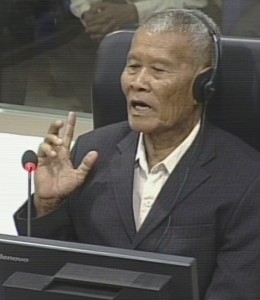
Witness Prum Sarun
After the break, the floor was given to the Nuon Chea Defense Team. Mr. Koppe inquired whether Mr. Sarun had ever heard in the last year of Democratic Kampuchea regime of fighting in Svay Rieng between Vietnamese and Cambodian troops, which Mr. Sarun had not. Mr. Koppe asked again – “just to be sure” – whether the arrest of Ta Chham took place before the question posed by Ta Krok, which Mr. Sarun confirmed. He recounted that after Ta Chham disappeared, Ta Krok asked him about the Vietnamese for the second time. In the next sentence, he said that Ta Krok asked him for the second time before the arrest of Ta Chham.
As for the rebellion that he had mentioned in his Written Record of Interview, Mr. Sarun recounted that the rebellion became known to the Khmer Rouge. It unfolded because people said that there was oppression by the Khmer Rouge. Thus, people were called to meetings to find out who was behind these rebellions. When Mr. Koppe asked whether he knew about Northwest Zone cadres raising arms to start a rebellion, he answered that he could not recall this.
Mr. Koppe asked whether he had ever heard that Northwest Ta Nhim or Ta Chham were part of the rebellion, which the witness did not know.
Another witness had talked about the arrest of Yeay Nae – a nationalized Yuon –who was subsequently released. Mr. Sarun had never heard of nationalized Vietnamese who were released.[6]
Mr. Koppe then asked whether Mr. Sarun remembered having talked about Tet Sambath – a singer from Phnom Penh – in his interview. Mr. Sarun recounted that his hands were tied behind his back and then he disappeared. They used to work together in Dangkaor. Mr. Koppe asked whether he knew that this person had a son who was a journalist in Phnom Penh now, which the witness denied.
Authority structures
Khieu Samphan Defense Counsel Anta Guissé took her stand and inquired about Battalion 2. She asked who the commander of the second battalion was. He replied that Ta Yi was the chief of Battalion 2.
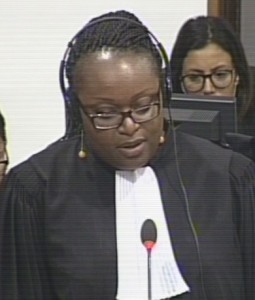
International Khieu Samphan Defense Counsel Anta Guissé
Ms. Guissé then inquired where Ta Koch was from. He replied that he was placed in Phnom Srung. He was shot to death. Ta Che also “got bullet wounds.”
Ms. Guissé asked what the subordinates of Ta Kroch were. He recounted that there was someone called Ta Boeun. Ta Boeun worked within another battalion. Ms. Guissé repeated her question, since Ta Boeun did not work below Ta Kroch. He then said that Ta Hong was the one who worked under Ta Krouch. Ta Hong was the witness’s direct superior.
Ms. Guissé then inquired whether he knew someone called Um Sun, which he denied. She then wanted to know whether had heard about the Khmer Sar movement. He said that he could not remember much about this movement. Ms. Guissé then asked whether he knew Ta Yat, which Mr. Sarun did not.
She then referred to another interview, during which a witness had referred to an arrest of Ta Yat.[7] He said that he did not know about this.
Mr. Sarun was afraid of Ta Chhat, since he had heard that he had killed many people. This was a rumor. With this, the testimony of Mr. Sarun came to an end. The President thanked the witness, wished him good luck, prosperity and health, and dismissed him. He then ordered the court assistant to usher the next witness in.
New Witness: Um Sun
The 64 year old witness Um Sun is was born in Sakda Village, Boeng Mealea Subdistrict, Svay Ley District, Siem Reap Province and is a rice farmer today.
The floor was first given to the Co-Prosecutors. Senior Assistant Prosecutor Vincent de Wilde inquired about his life during the Khmer Rouge. He was in a mobile unit in the community. He was working on a rice field. His unit was working in Cheang Village, Sangveuy Commune. He was about 28 years old in 1975. He did not know which sector it was located it. It was in Cheang village, Chikreng District, Siem Reap Province.
His village was next to Ksach Pagoda. It was around 100 meters away. The area was generally known as Cheang Village. Mr.de Wilde then wanted to know whether he knew someone called Sean Sung.[8] The witness replied that they secretly watched an execution together. He was older than Sean Sung. They were friends and working together.
Mr. de Wilde inquired whether New People settled in Sangveuy Commune after 1975, which the witness confirmed. He said that these included Ta Khut and Chantha. There were also Vietnamese people living in the area. “There was a Vietnamese family, belonging to Ta Khut and Yeay Ma, and they had a granddaughter named Chantha”. They were killed at Ksach Pagoda and their gallbladders were removed.
He did not know any other families than the two that he had mentioned. He knew that they were Vietnamese, because “the elders in the village all knew that they were Vietnamese. Everyone knew that they were Vietnamese”.
He knew them since his childhood. “They were good people […]. They were kind.” They lived in Khsach Village that was also known as Cheang Village. “I lived in Boeng Mealea commune for several years.” Mr. de Wilde then asked whether there were many Vietnamese people who had settled in the region before 1975, which the witness confirmed. “However, later on, I only saw the family of Ta Khut and Yeay Ma together with their granddaughter Chantha.”
He did not know what happened to the other families. He saw a family remaining in the village, before they were killed – the rest of the Vietnamese had gone. Mr. de Wilde then asked whether the witness knew if village or commune chiefs tried to identify Vietnamese people, which the witness did not know. He explained that he worked in the mobile unit and therefore did not know what happened in the village.
Mr. Koppe requested the bench to ask WESU to provide the copy of the witness’s ID, since there were some inconsistencies regarding his age. Judge Claudia Fenz said that this should be provided after the break.
Killings at Wat Khsach
After the break, Mr. de Wilde inquired when he stopped seeing the Vietnamese people in his village. Mr. Sun replied that it was from 1975 or 1976.
Mr. de Wilde requested leave to present the name of witness 2-TCW-846.[9] The leave was granted. The witness confirmed knowing that person. He knew him since Democratic Kampuchea.
Mr. de Wilde then referred to 2-TCW-846’s statement, who had said that there were lists drawn up about Vietnamese persons.[10] The witness said that he did not know. He never attended any meeting, since he was in charge of economics in the cooperative. He was tasked with finding fish in the river.
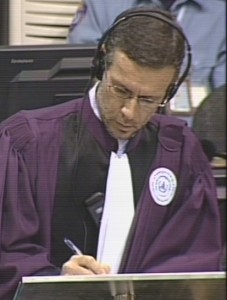
Senior Assistant Prosecutor Vincent de Wilde
Mr. de Wilde then turned to the pagoda and asked the witness to describe it. Mr. Sun confirmed that there was a fence around it. The fence was wooden. Nowadays the fence was made out of concrete. There were holes in the fence so that it was possible to see the pagoda from the outside. There was a library hall in the pagoda. It was seven meters wide and ten meters long. It was around three to four meters high. It was an ordinary house and the ground and not on stilts.
The execution took place around six or seven in the evening and lasted until ten at night. The people who were executed were Vietnamese. He knew that they were Vietnamese, because they had different accents. Because he heard screaming, he tried to see what was happening and saw the executions. The Vietnamese were placed in the library hall “and I could hear them talking.” This took place in 1975 or 1976.
In his statement, he had said that it took place in 1978.[11] Mr. de Wilde inquired whether this refreshed his memory. The witness replied that it took place in 1975, 1966 or 1977. “The executions took place for a few times from 1975 up to that year.” He noticed executions twice. He could not shed more light on this matter.
Mr. de Wilde then asked about Leunh Khun, who was the husband of Leunh – a witness – and whose mother Nha and younger sibling Kia were killed. This family was killed together with their child Chay and three other children “for the simple reason that the in-laws were Vietnamese”.[12] Mr. Sun replied that he knew that person. He replied that these people were killed during the second massacre. Mr. de Wilde stated that the witness had said that it took place in 1978. Mr. Sun did not know about the background of Leunh Khun.
Mr. de Wilde inquired whether any reason was given to Chantha why she was led to the pagoda. Mr. Sun replied that he heard villagers say that Chantha was taken for re-education. “In fact, after that Chantha disappeared.” After a few days later, they noticed that Chantha had disappeared. They saw bodies in a pit. He did not go there to see whether Chantha’s body was outside the pit. He was around 30 meters away from the pit.
He saw her dead body and then ran back home. He said that he was so frightened that he “did nothing else than running back home. I ran very very fast”, he said, after having witnessed “that horrible event.” He heard the screaming when he returned home. “That’s when I saw the execution unfolding before my eyes”. He heard the screaming and sound of beating in the evening.
Mr. Koppe objected to the question whether the people who were detained had a possibility to escape, since this invited the witness to speculate. Mr. de Wilde objected and asked whether there were people who escorted the detainees. Mr. Sun replied that the people who escorted them to the temple had guns, albeit the people were killed with clubs.
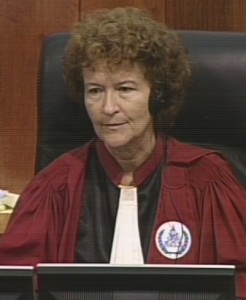
Judge Claudia Fenz
Mr. Koppe interjected. He reasoned that the witness continuously contradicted himself. Judge Claudia Fenz stated that Mr. Koppe was testifying now himself and that he should wait until he could ask questions.
The questioning continued. The witness recounted that the people were placed into the library at around 4 pm, while he heard the screaming in the night. Sean Sung was with him. Pressed on about the executions, the witness said: “And please, listen to me carefully. […] At night time, they were taken out the library hall and executed.” The next day, the library hall was open and the library was empty. He decided to run home at night time. He did not know how long exactly he was staying. “Although it was dark, we could recognize each other.” He did not shed light on the matter how long he stayed there.
Mr. de Wilde said that his Written Record of Interview indicated that he stayed there for around an hour and asked whether this was correct. He replied that by the time he ran back home, “they finished the execution.” He remembered how scared he was: his body was shaking and he was scared that the executioners would see him. When Mr. de Wilde asked how Mr. Sun was able to hide tens of meters away, Ms. Guissé objected and stated that he had heard thirty meters away. Mr. de Wilde replied that Ms. Guissé had not understood him correctly, since he had said tens of meters. When he repeated the question, the President interrupted him and said that there was a difference between ten and thirty meters. Mr. de Wilde repeated that he had said a few tens of meters.
They hid behind a palm tree and a tamarind tree. “We were about thirty meters away from the execution site. We were frightened.” The crawled there to have a look. There was a canal along the fence of the pagoda. “This is where I was watching.” It was to the east of the pagoda fence. The canal was three meters wide. There were gas mantles to light up the place, so he could clearly see the scene. After a while, they decided to crawl back and run back home. He heard them cry and heard them scream. “We crawled, we bent our head, and we tried to see what happened. And of course I saw the executioners.” They used the words Yuon. They were walked and executed individually.
He did not see anyone being spared. “Nobody was let out to go anywhere.” He did not hear a few people say that they were Chinese and not Vietnamese. He only heard the word “Yuon” being used. All Vietnamese had disappeared after the executions. “They were all executed, no one was spared.” Those who he knew never returned. “The babies and children were smashed against the coconut trees.” The older children were killed with bamboo clubs. Smaller children were held by their legs and smashed against the tree.
Mr. de Wilde moved to another topic and asked who the chief of his village was. Mr. Sun replied that the village chief was Kdeung. He had passed away. Mr. de Wilde asked whether there was another cadre who was called Soy or Say. The witness said that he knew him. He further said that all of these people had deceased by now. Mr. de Wilde inquired whether he heard Say mentioning that he had received instructions to assemble the Vietnamese.
As for Chantha, her abdomen was cut open, her gallbladder taken out “and the gallbladder was hung on the coconut trees.” He did not know how many gallbladders were taken out. The gallbladders of unmarried women were removed.
He saw the gallbladders hanging on the coconut tree. From his estimation “there were many gallbladders which were removed from a quite [high] number of people.” He could see the gallbladders when he went to the execution site. He did not know about the reasons for removing the gallbladders.
Clarifications
After the break, Mr. de Wilde inquired how many executioners were on sight. He saw a group of three people: two escorted the people to the site and one was the executioner. This applied to one person. The person had the hand tied back. They rotated, meaning that the executioner changed. “They were not soldiers. They were soldiers, who based themselves there.” He knew two of the: Khun and Muoy. Mr. de Wilde asked for clarification. The witness replied that there was also a military unit at the pagoda, which was based there. There was also a group of militiamen based in the pagoda. They were in the same unit as the executioners. According to the witness, the executioners Muoy and Khut could be in their sixties or late fifties today. He did not know whether they belonged to the commune or the district. He estimated that there were around 25 people in the library. He could not estimate the number of people who were killed in total “since there were two phases of killings.” Mr. de Wilde stated that the other witness estimated that around 100 to 120 people were being executed and asked whether he could explain the difference in numbers. Mr. Sun replied that people were brought in and executed there. There were two ponds: one small pond and a big pond. The well was located outside the pagoda but close to the fence.
He did not witness the first execution, but only the second one together with Sean Sung, where they saw the execution of Chantha. He saw gallbladders hung up against the coconut tree leaves wall. He saw wooden clubs left there. He saw a pit covered with dirt and limbs being exposed in there. He did not look inside the pit.
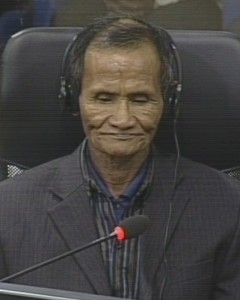
Witness Um Sun
Mr. de Wilde then asked whether the 100 people also were Vietnamese, and if yes, on which elements he based that. Mr. Sun replied that he knew Ta Khun, Yeay Ma and Chantha clearly. Mr. de Wilde pressed on and inquired about the 100 bodies that the witness claimed to have seen of having been thrown into the pond. He wanted to know whether these people were Vietnamese or not. He replied that he did not see it clearly. He did not dare to go close.
Mr. de Wilde then asked whether he understood it correctly that Leunh Khun’s family was killed at a different execution than Chantha’s family. The witness replied that they were related to Chantha, since they were Vietnamese.
The floor was then granted to the Civil Party Lawyers. Lead Co-Lawyer Marie Guiraud asked whether she understood him correctly that there were two groups taking part in the execution: people who belonged to the military unit and militiamen, which the witness confirmed. The former group was stationed at the pagoda. When Ms. Guiraud asked when the group arrived, he replied that “it started in 1975 and it continued through 1976, 1977, 1978 and 1979.” They were stationed there permanently. He did not know whether they belonged to the district, commune or zone level. They were in charge of the overall administration in the commune and the district. Khut and Muoy were the militiamen belonging to the commune. Ry, Soeun and Kung were in overall charge in that location, including the commune and the district.
Ms. Guiraud asked whether Khut and Muoy were members of the military unit or the militiamen. Mr. Sun replied that they were militiamen belonging to the commune. Ry, Lung and Soeun were higher in the hierarchy. He did not know where Ry was from, but the others came from Kampong Cham. Ms. Guiraud then asked whether he had seen Khut and Muoy after the execution again. Mr. Sun replied that he saw them when “the pigs were slaughtered” in Kampong Kdey. Afterwards, he had not seen them again. There was no further discussion about Khut and Muoy, so he did not know what happened to them. He did not recognize anyone else. He remembered that Soeun, Ry and Kung were in charge of his area.
He did not know who carried out the executions near the pond. With this, Ms. Guiraud finished her line of questioning.
Duties of the witness
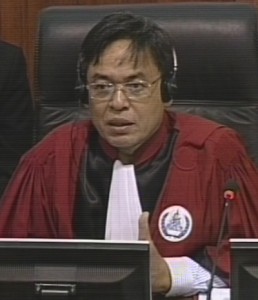
Trial Chamber President Nil Nonn
The floor was given to Nuon Chea Defense Counsel Victor Koppe who doubted that anything that the witness had said: “With all respect, I don’t believe a word of what you’re saying. So I’m putting it to you that you never witnessed any execution, any dead bodies […].” When he continued saying what he did not believe had happened, the President interrupted Mr. Koppe and said that he was not allowed to make his own submissions. Mr. Koppe replied that he was entitled to ask the witness “that he never saw” the executions and the like. The President again interrupted him and said that he was not entitled to make submission. Mr. Koppe asked the President whether he was not allowed to ask the witness whether he was lying or not, which the President confirmed. He prevented Mr. Koppe from putting the question to the witness. Mr. Koppe briefly said “fine” and sat down.
The floor was then granted to the Khieu Samphan Defense Counsel. Ms. Guissé asked about his function during the Democratic Kampuchea regime. He replied that he was in a mobile unit. He was instructed to make fertilizer and catch fish. He was stationed close to the river. Moreover, he was assigned to stand guard at night time. He did not have any weapons with him when he stood guard. Ms. Guissé asked him in what role he was assigned as a guard. She wanted to know whether he was a militiaman, which he denied. “I was simply an ordinary citizen.” He was assigned to stand guard along the road. “I was not assigned to stand guard in the pagoda”, since the guards in the pagoda were armed. People were allowed to walk around the cooperative worksites, but not at night time. They stood guards in groups and took shifts. After their shift, they were allowed to go back home. He stood guard at night time and not during the day.
As for work hours, he would sometimes work from the morning until the late evening. He would come back home around 5 pm at the latest. Sometimes he would return earlier. He would go home directly after work. He would sometimes have dinner at 4 pm or 5 pm. If they were late for dinner, they would have nothing to eat. He confirmed that everyone ate at the same time, their eating hour being indicated by a bell. The pagoda was located around 300 meters from his house.
She then inquired whether he stayed at the same home between 1975 and 1979, which he confirmed. The canteen was quite far away from the pagoda, maybe around 500 meters. He would go home directly after work and then he would go to the canteen when he heard the bell.
Ms. Guissé turned to asking about his friend Sean Sung. His friend’s house was around 100 meters away from his. “We worked together.” He fished together with two other people, during which time Sean Sung never joined them.
They would not work together all the time. Sean Sung and he were both in a children unit, but had different tasks. One of them had to go and tend buffalos and cattle, while the other had to make fertilizer. Thus, Sean Sung was assigned to tend cattle.
Ms. Guissé then turned to the topic of guarding the road and asked during what hours he guarded the road. There were different shifts. If there was a group of 10 people, they would be on duty for half an hour or an hour, before being replaced by another person.
Mr. Sun said that he had not recently seen Sean Sung, since he was now living in Khleang. They used to live together. He clarified that they used to live in the same village but not anymore. They separated after the liberation day.
At this point, the President adjourned the hearing. Since there is a national holiday tomorrow, it will resume Friday December 11, at 9 am, with the testimony of Sun and witness 2-TCW-848 being on the reserve.
[1] E3/5187, on p. 2 in all languages. [2] E3/6737, 00274160 (EN) 00226156 (FR), 00197883 (KH). [3] E3/5817, 00274179 (EN), 00197918 (KH), 00271486 (FR). [4] E3/5211, at 00221544-45 (KH), 00485979 (FR), 00275399 (EN). [5] E3/5185, at 00197889 (KH), 00226162 (FR), 00271466 (EN). [6]E3/7737, at 00274160 (EN), 00197883 (KH)m 00226156 (FR). [7] E3/5182, at 00223092 (FRI), 00197935 (KH), 00274149 (EN). [8] This witness had testified on October 28 of this year. [9] E3/7685. [10] E3/7685, p. 2 in all languages. [11] E3/7778, Answer 2. [12] E3/7686, 00332891-92 (FR), 00275406-07 (EN) 00221620-21 (KH).
